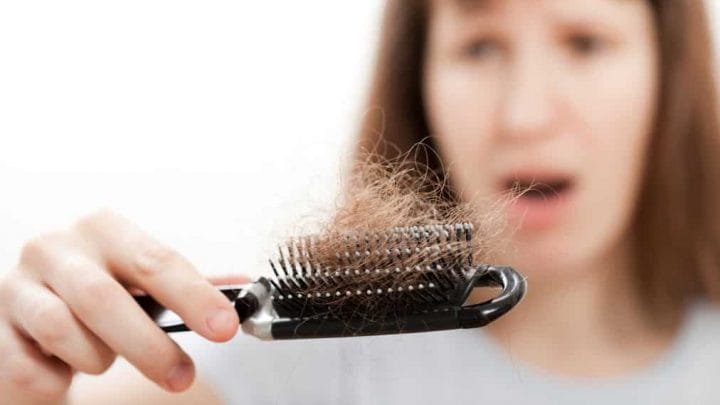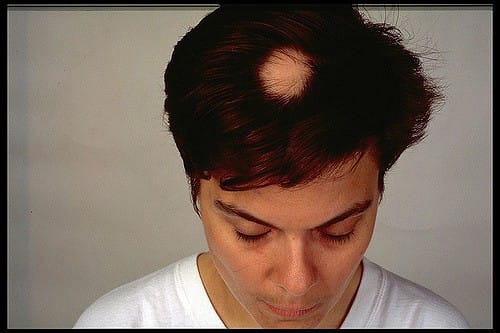
Alopecia areata – causes, symptoms and treatment
Text updated 31.03.2021
Accelerated and often difficult to control hair loss, primarily affecting the scalp, is a serious problem of both medical and cosmetic nature. It is encountered by more and more people, regardless of age or gender, unfortunately also by younger and younger people, we deal with them even in persons between 20 and 30 years of age. There are many varieties of this serious disease commonly called alopecia, and one of the most troublesome and difficult to treat at the same time, is alopecia areata. Its characteristic symptoms cannot be overlooked or underestimated. They almost completely change the appearance and cause not only physical but also mental suffering, even resulting in severe depression.
Contents
What is alopecia areata
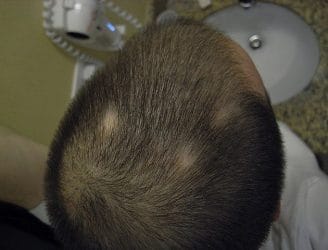
Alopecia areata, known by its Latin name alopecia areata, is a serious disease of the scalp. The course of the disease causes inflammation around the hair follicle, as a result of which it becomes damaged, which may also lead to its complete destruction, which is the cause of excessive hair loss. This type of alopecia affects both men and women and is a relatively uncommon variety, estimated to affect only 2 percent of all cases.
This does not mean, however, that it should be completely ignored, it is better to prevent it at the very first symptoms, which can often be observed in children as young as several years old. If it is not diagnosed and treated quickly enough, it leads to a complete and usually irreversible hair loss.
What are the causes of this inflammatory disease
Considering alopecia areata, the causes of this condition are extremely difficult to specify, but in most cases, doctors believe that disorders of the functioning of the immune system are responsible for it. Under their influence, it begins to attack its own cells, including the skin, leading to inflammation of the hair follicles, weakening the base of the hair itself and, as a result, its loss.
So you can safely consider this variety of alopecia as an autoimmune disease, but it is not only caused by a defective immune system. Specialists, primarily dermatologists, also mention other causes, which are:
- genetic factors, hereditary tendency to such hair loss, which can cover from 10 to 20 percent of all cases, also concerning the tendency to folliculitis;
- psychosomatic disorders and related conditions. This baldness is often associated with severe stress acting destructively also on hair follicles. Long-lasting nervous tension weakens the health of the whole organism, and one of its symptoms is the formation of characteristic inflammatory foci, places from which large amounts of hair start to fall out;
- negligence of scalp hygiene, irregular washing of the skin or using improper cosmetics, full of ingredients that interfere with the natural pH of the skin, which may also cause redness and irritation, ending in the development of inflammation;
- Hormonal disorders, most often occurring in pregnant or menopausal women and the lack in the body of certain nutrients that promote skin and hair health, such as zinc;
- circulatory problems causing hypoxia of the skin quickly leading to disorders of all three cycles of hair growth, i.e. anagen, when it is actively growing, catagen, a transition phase in which the hair begins to slowly die and telogen, when the hair does not grow anymore and the empty hair follicles rest and regenerate;
- co-morbidities, including autoimmune diseases, among which skin diseases such as vitiligo or even simple untreated acne should be mentioned first. However, a much greater threat to the hair are other diseases, thyroiditis, hyperthyroidism, hypothyroidism, or particularly dangerous Hashimoto disease. Hair loss can also be caused by lupus erythematosus, type 1 diabetes mellitus, rheumatoid arthritis, and inflammation of the digestive system, especially the large intestine;
- hypersensitivity to other external factors, including atmospheric or caused by allergies, including food allergy
- infections of bacterial nature, caused, among others, by staphylococci, streptococci, or by bacteria that can cause diseases whose symptom is also baldness, such as skin tuberculosis, syphilis and gonorrhea.
The most common types of the disease
Looking at people suffering from this ailment, you may be under the mistaken impression that there is only one variety of this extremely troublesome disease. In reality, however, we are dealing with several types, and the most common are:
- total alopeciaareata, which, as its name suggests, covers the entire surface of the head and leads to complete hair loss, which, however, remains in other parts of the body;
- malignant alopecia areata, the most severe form of the disease, which begins, as any other, with the formation of small patches of hair loss. These areas gradually enlarge and complete baldness occurs, with the difference from the total variety that, despite treatment, the hair does not grow back and their loss is usually permanent;
- alopecia areata simplex, and in this variety, the course of the disease results in the formation of the aforementioned oval or round foci of alopecia, which may or may not merge or join together;
- generalized alopecia areata, another extremely troublesome variety, in which there is not only a gradual loss of hair on the head, but also eyebrows and eyelashes, and often hair in other parts of the body, such as the intimate area or under the arms;
- Diffusealopecia areata, in which individual hair follicles quickly merge into one another and cover the entire head;
- alopecia areatanodosa, also called alopecia areata fringata, is an alopecia areata that develops primarily at the scalp’s periphery in the frontal, temporal and occipital regions. In the case of alopecia areata, virtually one hundred percent of the hair is lost with only small clumps of hair remaining on the crown of the head.
Other criteria for the classification of alopecia areata
The above criteria for the classification of alopecia areata are not the only ones available. There is also a classification based on the duration of the disease, developed by a Japanese physician T. Ikeda, who divided the disease into four categories as follows:
1. alopecia areata vulgaris
Characteristic of alopecia areata is the rapid progression of the disease, the appearance of large patches of bald patches on the skin, which usually disappear just as quickly and spontaneously.
2. atopic alopecia areata
As its name suggests, it very often accompanies another dangerous disease, atopic dermatitis. Focal areas of alopecia can cover a large part of the head and are also much more difficult to treat.
4. hypertrichosis albicans
As difficult to control as in the second point, and in its severe course, foci of alopecia cluster together, which causes problems with choosing the right treatment.
5 Combined alopecia areata
This type of disease is usually directly related to the above-described coexisting autoimmune diseases, mainly thyroid and other endocrine glands, whose malfunction may disrupt the entire hormonal balance of the body.
The most characteristic symptoms of alopecia areata
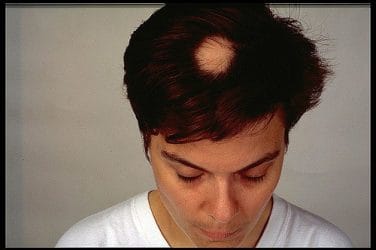
Symptoms of alopecia areata are so characteristic that they are really difficult to miss and confuse with other types of this disease. As already mentioned, the first symptoms can be observed in children as young as a few years old and if they occur, they should be immediately addressed by taking the child to a dermatologist. Our concern should be raised:
- small alopecia foci, round or oval areas, from which hair begins to fall out at a rapid pace, and the foci themselves often spread, enlarge and merge with each other;
- appearing on the outskirts of these foci so called exclamation hair, which are short, hard, just a few millimeters fragments of hair, looking as if they were crookedly cut;
- itching of the skin in the affected areas, with no other signs of inflammation, irritation or redness;
- symptoms of psychological nature, associated with a deteriorating psychological well-being, declining self-esteem and a growing sense of embarrassment that hinders, and in many cases even prevents normal social functioning. It leads to increasing stress, and even to mentioned depression, a condition which may already threaten patient’s life;
- changes appearing on nails, occurring in up to 60 percent of patients, manifested by transverse grooves on their plate, called Beau lines, brittleness of the nail plate, its thickening, and in severe cases of the disease even falling off;
- symptoms of eye disorders such as progressive cataract, i.e. clouding of the lens, which fortunately occurs very rarely.
The most common methods of treatment of alopecia areata
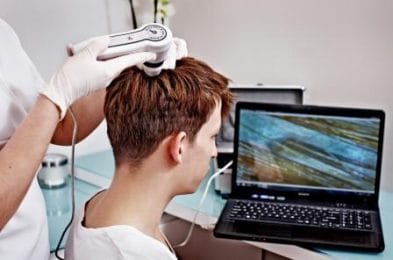
Taking into account other types of baldness, we can safely say that alopecia areata is one of the most difficult to treat. This state of affairs is influenced, among other things, by problems with correct determination of the cause of the disease, which makes it difficult to make the right diagnosis that determines the choice of the most effective treatment method. A visit to the dermatologist is a must, however, and must not be avoided or treated on one’s own as it can make the condition of one’s hair even worse rather than better . Only a doctor is able to correctly identify individual, often seemingly unrelated symptoms and combine them into one whole, making an accurate diagnosis.
The first step is always a visual inspection, examination of the scalp, hair and nails of the patient for the above mentioned symptoms. It is also possible to use histopathological examination of a section of skin, laboratory test, used in suspicion of autoimmune diseases. Useful and applied by e.g. trichologists, is a dermoscopic examination, i.e. a device showing the skin in the vicinity of hair follicles, the follicles themselves and the structure of hair at high magnification. Only on its basis selects the means that will be used for treatment, and its application is a lot, both natural and artificial origin and various treatments.
What works in alleviating the symptoms and treating alopecia areata:
- Immunosuppressive agents such as corticosteroids administered orally as tablets, or topically, creams and ointments applied directly to hairless skin;
- minoxidil, which also works well for the treatment of androgenetic alopecia and was initially used only as a blood pressure-lowering drug. It prevents conversion of testosterone into DHT, dihydrotestosterone, which damages and in time destroys hair follicles. Its use carries a number of serious side effects, chest pains, blood pressure spikes, hyperglycemia, or menstrual disorders in women;
- DCPC therapy, in which an anti-allergic agent, usually diphenylcyclopropenone, is introduced under the skin, causing local sensitization;
- supplementing existing deficiencies of vitamin D, extremely effective in eliminating inflammation, also within the hair follicles responsible for proper hair growth;
- use of appropriate cosmetics that promote healthy and fast hair growth and at the same time take care of skin health, preventing inflammation, irritation, maintaining its proper pH;
- mesotherapy, i.e. a procedure consisting in injecting nutritional substances required directly under the skin, which are also beneficial for hair follicles and hair bulbs;
- carboxytherapy, another invasive treatment, but in this case carbon dioxide is injected under the skin, which has a beneficial effect on blood vessels, causing their enlargement and, consequently, better blood supply, oxygenation and nutrition of the scalp;
- cryomassage, also a treatment, but this time an external one, involving cooling of skin tissues with the use of nitrous oxide, administered with a special device. The effect of such action is to stimulate the skin, especially hair follicles to faster regeneration;
- UVB therapy, using ultraviolet radiation, strengthening the follicles and accelerating the growth of new, stronger and healthier hair;
- medications to alleviate the symptoms of other diseases that may result in alopecia areata, the most important of which are anti-stress preparations based on natural ingredients such as vitania sluggishis, better known as ashwagandha.



